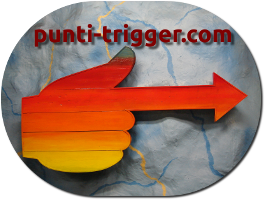Since there is without doubt an analogy between trigger points and acupoints, and Janet Travell's preferred treatment method itself was that of transfixing the trigger points with the needle of a syringe of proper dimensions, the question naturally arises as to whether there is connection or identity between acupoints and trigger points.
However, we can immediately state that there is no perfect correspondence.
First of all, while myofascial trigger points are always contained in muscular tissue, acupoints can be localized also in different types of tissue.
Moreover, while all trigger points produce pain when stimulated, not all acupoints cause pain following a stimulus. For this very reason, in Traditional Chinese Medicine those acupoints that generate pain constitute a particular subclass of acupoints that are overall called ah-shi points or tender points, where the Chinese word ah-shi literally means "oh yes", which is to say, "this is the right point."
Finally, from a theoretical point of view, acupuncture is based on concepts such as Qi or Chi and Meridians, concepts, that is, which are foreign to the Western medical understanding within which the Trigger Point discipline has, after all, evolved. The scope of acupuncture is also broader that the scope of trigger point therapy and acupuncture aims at obtaining improvement and cure for conditions of any nature, not only for myofascial syndromes.
But in spite of these profound differences, the fact remains that according to several experts, many acupoints have a quite accurate correspondence to many classic trigger points. According to a study by R. Melzak titled Myofascial trigger points: relation to acupuncture and mechanisms of pain ( Arch Phys Med Rehabil. 1981 Mar;62(3):114-7.), as well as according to subsequent studies, there is good correspondence with known acupoints in about 70% of the examined cases (see the excellent research http://www.medicalacupuncture.com/aama_marf/journal/vol17_3/article_3.html).
My own conclusion is that trigger points are a subset of the acupoints of Traditional Chinese Medicine both as far as number and as far as scope or therapeutic reach. But then, the undeniable correspondence of these subsets of points is very interesting because the theoretical postulates of the two medical systems are fundamentally different. Incidentally, the validity of acupunture appears undeniably confirmed from the above comparison.
Travell and Simons describe 255 trigger points in their seminal work, while the most commonly accepted acupoints are 747, and so it has been possible to conduct comparison sudies and it is possible to deepen such study further in the daily practice of the massage therapist, chiropractor, osteopath or acupuncturist who has built a backgroud in both acupressure and trigger point therapy.
It would seem an excellet idea to deepen the knowledge of the acupoints along with the therapeutic trigger point practice, always from the applied and empirical standpoint from which alone pains can be made to disappear.
